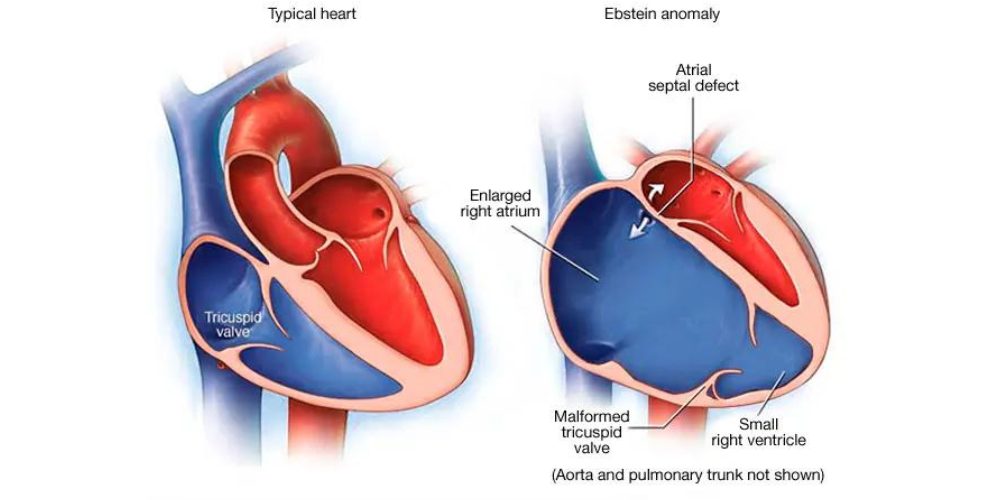Before diving into Ebstein anomaly, let’s revisit some basic heart anatomy. Our heart has four chambers: two upper chambers called atria and two lower chambers called ventricles. The tricuspid valve separates the right atrium, which receives blood from the body, from the right ventricle, which pumps blood to the lungs for oxygenation.
What is Ebstein Anomaly?
Ebstein anomaly is a congenital heart defect affecting the tricuspid valve. In a healthy heart, the tricuspid valve has three leaflets that open and close smoothly, ensuring blood flows in the right direction. In Ebstein anomaly, these leaflets are misplaced, positioned deeper within the right ventricle instead of their usual location. Additionally, one leaflet is often abnormally enlarged and may even be attached to the ventricle wall.
This malformation disrupts the tricuspid valve’s function. It might not close properly, causing blood to leak backward from the ventricle to the atrium (tricuspid regurgitation). In severe cases, the right ventricle itself becomes enlarged and dysfunctional.
Severity and Symptoms of Ebstein anomaly
The severity of Ebstein anomaly varies greatly. Some babies are born with significant symptoms, while others may not experience any issues for years. The severity depends on the degree of valve malformation and regurgitation.
Here’s a breakdown of possible symptoms:
- Newborns: Rapid breathing, bluish skin color (cyanosis), feeding difficulties, and poor growth.
- Infants and Children: Fatigue, shortness of breath during exertion, heart palpitations (feeling like the heart is racing or fluttering), and swelling in the legs or abdomen (due to fluid buildup).
- Adults: Some adults with mild Ebstein anomaly might not have any symptoms. However, others may experience progressive fatigue, shortness of breath, and heart rhythm problems (arrhythmias).
Diagnosis of Ebstein Anomaly
Diagnosing Ebstein anomaly often involves a combination of tests:
- Prenatal screening: In some cases, Ebstein anomaly can be detected during a fetal echocardiogram, a detailed ultrasound scan of the baby’s heart in the womb.
- Echocardiogram: This painless ultrasound exam uses sound waves to create images of the heart, allowing doctors to assess the structure and function of the tricuspid valve.
- Electrocardiogram (ECG): This test measures the heart’s electrical activity and can help identify arrhythmias.
- Chest X-ray: While not definitive for Ebstein anomaly, a chest X-ray can show an enlarged heart size.
Treatment Options for Ebstein Anomaly
The course of treatment depends on the severity of the condition. In mild cases, regular monitoring with an echocardiogram may be sufficient. However, if symptoms are present or the heart function is compromised, intervention may be necessary.
Treatment options include:
- Medications: Diuretics can help reduce fluid buildup in the body, and medications may be used to control heart rhythm problems.
- Surgery: Open-heart surgery can be performed to repair or replace the tricuspid valve, improve blood flow, and restore normal heart function.
Living with Ebstein Anomaly
With proper management, many children and adults with Ebstein anomaly can lead active and fulfilling lives. Regular follow-up with a pediatric cardiologist is crucial to monitor the condition and adjust treatment as needed.
When to Seek Medical Attention
If your child experiences any symptoms suggestive of Ebstein anomaly, such as rapid breathing, fatigue, shortness of breath, or bluish skin color, it’s important to seek immediate medical attention. Early diagnosis and management are key to ensuring the best possible outcome.
The Importance of Pediatric Expertise
Ebstein anomaly requires specialized care. Pediatric cardiologists have the expertise and experience to diagnose and manage this complex condition effectively. They understand the unique needs of children’s hearts and can provide comprehensive care throughout childhood and into adulthood.
A Word of Hope
While Ebstein anomaly can be a concerning diagnosis, advancements in medical technology and pediatric cardiology expertise offer a positive outlook for children born with this condition. With proper management and support, children with Ebstein anomaly can thrive and live full lives.


